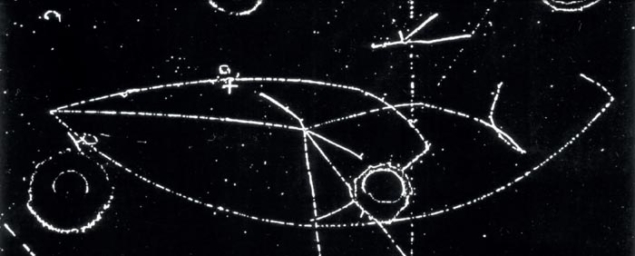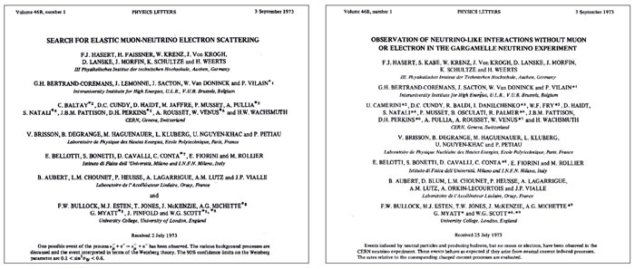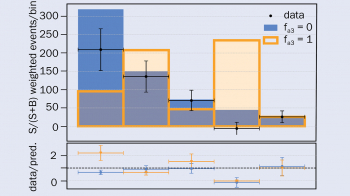Luciano Maiani reflects on the impact of the observation on the occasion of the 40th anniversary.

In a seminar at CERN on 19 July 1973, Paul Musset of the Gargamelle collaboration presented the first direct evidence of weak neutral currents. They had discovered events in which a neutrino scattered from a hadron (proton or neutron) without turning into a muon (figure 1) – the signature of a hadronic weak neutral current. In addition they had one leptonic event characterized by a single electron track (figure 2). A month later, Gerald Myatt presented the results on a global stage at the 6th International Symposium on Electron and Photon Interactions at High Energies in Bonn. By then, two papers detailing the discovery were in the offices of Physics Letters and were published together on 3 September. A few days later, the results were presented in Aix-en-Provence at the International Europhysics Conference on High-Energy Particle Physics, where they were aired as part of a large programme of events for the public.

Earlier in May, Luciano Maiani was with Nicola Cabibbo at their university in Rome when Ettore Fiorini visited, bringing news of what the Gargamelle collaboration had found in photographs of neutrino interactions in the huge heavy-liquid bubble chamber at CERN. The main problem facing the collaboration was to be certain that the events were from neutrinos and not from neutrons that were liberated in interactions in the material surrounding the bubble chamber (CERN Courier September 2009 p25). Fiorini described how the researchers had overcome this in their analysis, one of the important factors being the size of Gargamelle. “He explained that the secret was the volume,” Maiani recalls, “which could kill the neutron background.” Maiani at least was convinced that the collaboration had observed neutral currents. It was a turning point along the road to today’s Standard Model of particles and their interactions, he says.
Weak neutral currents, which involve no exchange of electric charge between the particles concerned, are the manifestation of the exchange of the neutral vector boson, Z, which mediates the weak interaction together with the charged bosons, W±. The discovery of these neutral currents in 1973 was crucial experimental support for the unification of electromagnetic and weak interactions in electroweak theory. This theory – for which Sheldon Glashow, Abdus Salam and Steven Weinberg received the Nobel Prize in Physics in 1979 – became one of the pillars of the Standard Model.
For Maiani, the theoretical steps began in 1962 with his colleague Cabibbo’s work that restored universality in weak interactions. The problem that Cabibbo had resolved concerned an observed difference in the strength of weak decays of strange particles compared with muons and neutrons. His solution, formulated before the proposal of quarks, was based on a weak current parameterized by a single angle – later known as the Cabibbo angle.
During the next 10 years, not only did the concept of quarks as fundamental particles emerge but other elements of today’s Standard Model developed, too. In 1970, for example, Maiani, Glashow and Iliopoulos put forward a model that involved a fourth quark, charm, to deal correctly with divergences in weak-interaction theory. Their idea was based on a simple analogy between the weak hadronic and leptonic currents. As their paper stated, the model featured “a remarkable symmetry between leptons and quarks” – and this brought the neutral currents of the electroweak unification of Weinberg and Salam into play in the quark sector. One important implication was a large suppression of strangeness-changing neutral currents through what became known as the GIM mechanism.

Maiani now says that at this point no one was talking in terms of a standard theory, even though many of the elements were there – charm, intermediate vector bosons and the Brout-Englert-Higgs mechanism for electroweak-symmetry breaking. However, perceptions began to change around 1972 with the work of Gerardus ‘t Hooft and Martinus Veltman, who showed that electroweak theory could be self-consistent through renormalization (CERN Courier December 2009 p30). After this leap forward in theory, the observations in Gargamelle provided a similar breakthrough on the experimental front. “At the start of the decade, people did not generally believe in a standard theory even though theory had done everything. The neutral-current signals changed that,” Maiani recalls. “From then on, particle physics had to test the standard theory.”
A cascade of discoveries followed the observation of neutral currents, with the J/ψ in 1974 and open charm in 1976 through to the W and Z vector bosons in 1983. The discovery of a Higgs boson in 2012 at CERN finally closed the cycle, providing observation of the key player in the Brout-Englert-Higgs mechanism, which gives mass to the W and Z bosons of the weak interactions, while leaving the photon of electromagnetism massless. In a happy symmetry, the latest results on this first fundamental scalar boson were recent highlights at the 2013 Lepton–Photon Conference and at the International Europhysics Conference on High-Energy Particle Physics, EPS-HEP 2013 – the direct descendants of the meetings in Bonn and Aix-en-Provence where the discovery of neutral currents was first aired 40 years ago.
“We are now stressing the discovery of a Higgs boson,” says Maiani, “but in 1973 the mystery was: will it all work?” Looking back to the first observation of neutral currents, he describes it as “a perfect experimental discovery”. “It was a beautiful experimental development, totally independent of theory,” he continues. “It arrived at exactly the right moment, when people realized that there was a respectable theory.” That summer 40 years ago also saw the emergence of quantum chromodynamics (CERN Courier January/February 2013 p24), which set up the theory for strong interactions. The Standard Model had arrived.•
For more detailed accounts by key members of the Gargamelle collaboration, see the articles by Don Perkins (in the commemorative issue for Willibald Jentschke 2003 p15) and Dieter Haidt (CERN Courier October 2004 p21).
Physicists meet the public at Aix
During the week of the Aix Conference more attention than usual was given to the need for communication with non-physicists. A plenary session was held on “Popularizing High Energy Physics” and on several evenings “La Physique dans la Rue” events were organized in the town centre.
One evening saw a more classical presentation of information with talks by Louis Leprince-Ringuet (on the beauties of pure research), Bernard Gregory (on the role of fundamental science and its pioneering role in international collaboration) and Valentine Telegdi (on the intricate subject of neutral currents). More than 600 people heard these talks, no doubt attracted particularly by the well known television personality of Leprince-Ringuet.
● CERN Courier October 1973 pp297–298 (extract).







